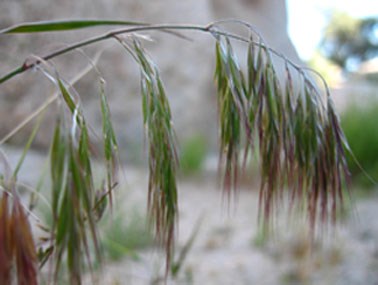Cheatgrass or Downy brome

Cheatgrass or Downy brome
(Bromus tectorum)
Priority: - Prevent / EDRR
Tags: Agricultural | Terrestrial
Identification and Reproduction
Introduction
- Cheatgrass is an annual or winter annual grass (Poaceae family) that grows in tufts.
- It has green, erect and slender stems. When mature it will grow to 75 centimetres.
- This plant has drooping spikelets or inflorencence that are multi-branched in a terminal cluster. These flower heads are soft and feathery.
Reproduction
It reproduces only by seeds, which can be moved by wind, animals, or people.
Habitat & Ecology
- Cheatgrass grows easily on disturbed sites and will commonly invade burned rangeland, heavily grazed grasses, and other open areas.
- It is commonly found in southern B.C., in grasslands, dry forests, or winter cover crops.
Impacts
Ecological:
- It is extremely invasive and tends to seed earlier than native species. Cheatgrass displaces native vegetation and reduces biodiversity.
- It has an extensive root system that tends to lower the site's water availability.
- Cheatgrass seasonally dries out by mid-June and adds wildfire fuel altering the fire regime of the area.
Management
- Cheatgrass should be prevented by regular monitoring of disturbed or grassy areas.
- It can also be prevent through land management, for example by maintaining a diversity of vegetation.
Resources
For information on cheatgrass identification and control check out the Columbia University's page on cheatgrass.
Header photo (Famartin).



